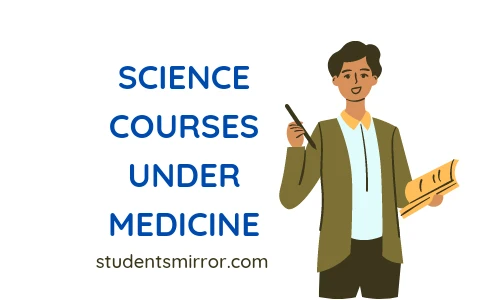In this article, we’ll be looking at a list of science courses under medicine. If you’re inquiring about science courses under medicine, then this article is for you. Read to the end.
Science Courses Under Medicine (Top List)
There are actually quite a few science courses that fall under the umbrella of medicine. Here are some of the most common ones:
1. Anatomy
Anatomy, a fundamental component of medical education, intricately explores the structural intricacies of the human body. Encompassing a comprehensive spectrum, this course delves into the microscopic realm, dissecting the organization of cells and tissues while concurrently navigating the macroscopic landscape and dissecting the intricate interplay of organs and systems. By unraveling the complexity of anatomical structures at both cellular and holistic levels, students gain a profound understanding of the human form, laying a crucial foundation for further studies in medicine and contributing to their ability to comprehend and address health-related challenges.
2. Biochemistry
Biochemistry, a cornerstone of the medical curriculum, illuminates the intricate chemical ballet within living organisms. This course navigates the realms of metabolic intricacies, delving into the transformations and interactions that define life processes. From the orchestrated breakdown of carbohydrates to the nuanced synthesis of proteins and lipids, students traverse the molecular landscape where cellular energy is harnessed, structures are built, and signaling pathways intricately coordinate physiological functions. By understanding these foundational chemical processes, students acquire a profound insight into the molecular underpinnings of life, forming a crucial basis for comprehending diseases and devising therapeutic interventions in the complex landscape of medical practice.
3. Physiology
Physiology, a vital component of medical education, serves as a dynamic exploration into the intricate functions that define the human body’s orchestration. This course spans the spectrum of biological organization, unraveling the mysteries from individual cells to the integrated functioning of whole organs and systems. Students delve into the marvels of cellular communication, organ coordination, and systemic regulation, comprehending the physiological intricacies that sustain life.
4. Pathology
Pathology, a pivotal domain in medical education, immerses students in the profound study of diseases, encompassing their origins, mechanisms, and consequential impacts on the human body. This course serves as a diagnostic compass, guiding students through the intricate landscape of pathological deviations. From elucidating the root causes of diseases to deciphering the intricate molecular and cellular processes that underlie pathological changes, students gain a comprehensive understanding of how deviations from normal physiology manifest into illness.
5. Pharmacology
Pharmacology, an essential facet of medical education, offers a comprehensive exploration into the intricate world of drugs. This course systematically dissects the mechanisms of action of various pharmaceutical agents, unraveling the ways in which they interact with the body to produce therapeutic effects. Beyond efficacy, pharmacology delves into the realm of potential side effects, ensuring a nuanced understanding of the risks and benefits associated with drug interventions. Additionally, students navigate the complex web of drug interactions, discerning how different medications may influence each other’s effectiveness or introduce unforeseen consequences.
6. Internal Medicine
Internal medicine, a cornerstone of medical training, focuses on the intricate landscape of non-surgical diseases, epitomizing the art and science of comprehensive patient care. This course delves into the diagnostic nuances of ailments affecting internal organs, emphasizing a holistic understanding of the body’s intricate systems. From cardiovascular and respiratory disorders to gastrointestinal and endocrine dysfunctions, students unravel the complexities of diverse medical conditions. The curriculum extends beyond identification, embracing the formulation of evidence-based treatment plans and addressing both acute and chronic illnesses. Mastery of internal medicine equips physicians with the expertise needed to manage a broad spectrum of health issues, fostering a patient-centered approach and underscoring the importance of preventive care and long-term well-being.
7. Surgery
Surgery, an integral component of medical education, immerses students in the dynamic realm of diagnosing and treating diseases necessitating surgical intervention. This course navigates the intricacies of surgical procedures, ranging from routine to complex interventions, emphasizing precision and proficiency. Students learn to assess conditions that warrant surgical approaches, gaining expertise in preoperative evaluation, surgical techniques, and postoperative care. From addressing trauma and tumors to managing congenital anomalies, the curriculum spans a diverse array of surgical specialties. Mastery of surgery not only hones technical skills but also cultivates critical decision-making abilities, enabling practitioners to provide timely and effective interventions for a broad spectrum of surgical conditions, thus contributing to the holistic care of patients.
8. Obstetrics and gynecology
This course covers the care of women during pregnancy, childbirth, and after childbirth.
9. Pediatrics
This course covers the care of children from birth to adolescence.
10. Psychiatry
This course covers the diagnosis and treatment of mental illnesses.
11. Public Health
This course covers the study of the health of populations, including the prevention and control of disease.
12. Epidemiology
Epidemiology, a fundamental discipline in public health and medicine, engages students in unraveling the intricate dynamics of disease at a population level. This course delves into the systematic study of patterns, causes, and methods of disease control. Students learn to scrutinize the distribution of diseases, discern underlying factors contributing to their occurrence, and explore strategies for prevention and intervention. Epidemiology equips medical professionals with the tools to comprehend the broader context of health challenges, ranging from infectious diseases to chronic conditions.
13. Biostatistics
Biostatistics, an integral component of medical and public health education, immerses students in the application of statistical methods to advance understanding in these fields. This course equips students with the analytical tools needed to interpret data, design experiments, and draw meaningful conclusions in the context of medicine and public health. From clinical trials assessing treatment efficacy to population-level studies investigating disease patterns, biostatistics plays a pivotal role in generating evidence-based insights. Students learn to navigate statistical models, analyze health-related data, and interpret findings critical for informed decision-making in healthcare. Mastery of biostatistics enhances a practitioner’s ability to critically evaluate research literature, contribute to study design, and ultimately improve the quality of healthcare delivery and public health initiatives through rigorous and evidence-driven approaches.

